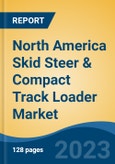Speak directly to the analyst to clarify any post sales queries you may have.
10% Free customizationThis report comes with 10% free customization, enabling you to add data that meets your specific business needs.
Growing infrastructure development, urbanization, and a surge in residential and commercial construction activities are further fueling adoption. Manufacturers are focusing on technological innovations such as telematics, improved hydraulics, operator comfort, and fuel efficiency to meet evolving customer needs. The rise in equipment rentals also contributes significantly to market expansion across the region. U.S. contractors financed 54,269 new compact track loaders between March 2024 and February 2025, marking a 12.9% year-over-year increase. This surge highlights the growing preference for CTLs, significantly contributing to overall market growth.
Market Drivers
Rising Infrastructure Development and Urbanization
One of the primary drivers of the North America skid steer and compact track loader market is the significant rise in infrastructure development projects and urbanization. Both federal and local governments are heavily investing in modernizing transportation networks, public utilities, and smart city initiatives. According to the U.S. Congressional Budget Office, federal spending on infrastructure is projected to exceed USD 1.2 trillion over the next decade, fueled in part by the Infrastructure Investment and Jobs Act (IIJA).Skid steers and compact track loaders are ideal for these applications due to their ability to operate in confined urban spaces and efficiently perform various tasks such as grading, digging, and material handling. The machines’ compact design and versatility make them indispensable for urban construction, where larger equipment may not be feasible. As urban areas continue to expand across the U.S. and Canada, the demand for these machines in roadwork, residential and commercial building construction, and municipal projects is expected to remain robust.
Key Market Challenges
High Initial Investment and Ownership Costs
One of the primary challenges in the North America skid steer and compact track loader market is the high cost associated with purchasing and owning this equipment. Although these machines offer versatility and efficiency, their initial price can be a significant barrier for small- and medium-sized contractors, landscapers, and farmers. In addition to the upfront cost, ownership includes ongoing expenses such as fuel, insurance, maintenance, repairs, and replacement parts.For compact track loaders, the cost of replacing rubber tracks and undercarriage components can be particularly high. These financial burdens can deter potential buyers, particularly in times of economic uncertainty or when project volumes are inconsistent. While equipment rental offers an alternative, businesses that require frequent or long-term use still face difficult decisions about whether to rent or buy. As a result, affordability continues to be a limiting factor in broader market penetration, especially among cost-sensitive user segments.
Key Market Trends
Rising Adoption of Compact Track Loaders Over Skid Steer Loaders
A significant trend in the North America market is the increasing preference for compact track loaders (CTLs) over traditional skid steer loaders (SSLs). While skid steers have long been favored for their agility and performance on hard, flat surfaces, CTLs are gaining ground due to their superior traction, lower ground pressure, and ability to operate effectively in muddy, uneven, or soft terrain. These capabilities make CTLs particularly attractive in applications such as landscaping, agriculture, forestry, and construction work in challenging environments. As job sites become more diverse and weather conditions less predictable, users are shifting toward machines that offer greater stability and versatility. This shift is prompting manufacturers to expand their CTL portfolios and invest in R&D to improve undercarriage durability, hydraulic power, and fuel efficiency.Key Market Players
- Bobcat Company
- CNH Industrial America LLC.
- Caterpillar Inc.
- AB Volvo
- KUBOTA Corporation
- Deere & Company
- Manitou Americas Inc.
- ASV Holdings Inc
- Wacker Neuson Group
- J C Bamford Excavators Ltd.
Report Scope:
In this report, the North America Skid Steer & Compact Track Loader Market has been segmented into the following categories, in addition to the industry trends which have also been detailed below:North America Skid Steer & Compact Track Loader Market, By Vehicle Type:
- Skid Steer
- Compact Track Loader
North America Skid Steer & Compact Track Loader Market, By Application:
- Construction
- Agriculture
- Others
North America Skid Steer & Compact Track Loader Market, By Country:
- United States
- Canada
- Mexico
Competitive Landscape
Company Profiles: Detailed analysis of the major companies present in the North America Skid Steer & Compact Track Loader Market.Available Customizations:
With the given market data, the publisher offers customizations according to a company's specific needs. The following customization options are available for the report.Company Information
- Detailed analysis and profiling of additional market players (up to five).
Table of Contents
Companies Mentioned
- Bobcat Company
- CNH Industrial America LLC.
- Caterpillar Inc.
- AB Volvo
- KUBOTA Corporation
- Deere & Company
- Manitou Americas Inc.
- ASV Holdings Inc
- Wacker Neuson Group
- J C Bamford Excavators Ltd.
Table Information
| Report Attribute | Details |
|---|---|
| No. of Pages | 131 |
| Published | August 2025 |
| Forecast Period | 2024 - 2030 |
| Estimated Market Value ( USD | $ 11.67 Billion |
| Forecasted Market Value ( USD | $ 14.83 Billion |
| Compound Annual Growth Rate | 4.1% |
| Regions Covered | North America |
| No. of Companies Mentioned | 10 |









